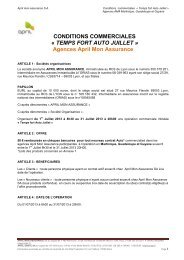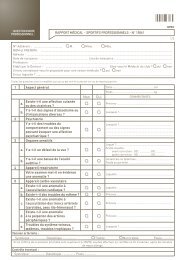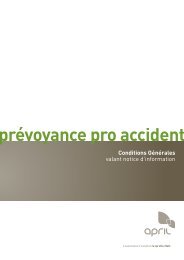2007 - April
2007 - April
2007 - April
Create successful ePaper yourself
Turn your PDF publications into a flip-book with our unique Google optimized e-Paper software.
3.0<br />
Chairman of the Board of Directors’ report<br />
Other 3 rd level control activities<br />
Within APRIL Assurances, Mutant Assurances and the Axeria<br />
Vie division, one dedicated person within each structure<br />
is responsible for internal control, contributing, through<br />
the 25 assignments carried out in <strong>2007</strong>, to ensuring that<br />
the company’s operational procedures are compliant with<br />
internal or external standards.<br />
In all of the Group’s divisions, the 19 members of staff in<br />
charge of quality audits have also contributed, thanks to<br />
the seven assignments carried out in <strong>2007</strong>, to these control<br />
activities in line with the Group’s internal control system.<br />
Internal audit plan<br />
The Group’s annual audit plan for N+1 is defined at the end<br />
of Year N by the Group Committee and validated by the<br />
Sustainable Development Committee.<br />
This plan is formally reviewed each half-year period. It may<br />
also be adapted according to the importance of new risk<br />
areas identified or any specific requests.<br />
More generally, all internal audit missions are carried out in<br />
line with the Group internal audit charter aiming to:<br />
1) Present and disseminate the objectives of internal audit<br />
missions within APRIL GROUP companies;<br />
2) Define the responsibilities of the various stakeholders in<br />
the APRIL GROUP internal audit process;<br />
3) Present the operating principles for internal audit and the<br />
practical conditions for its implementation within APRIL<br />
GROUP.<br />
Each internal audit assignment is covered by a mission<br />
statement signed by APRIL GROUP’s Chairman and Chief<br />
Executive Officer and a detailed work program. These<br />
documents are sent out to the manager of the company in<br />
question prior to the assignment.<br />
Types of internal audit missions<br />
We differentiate between the following types of mission:<br />
Cross-business missions and optimizations<br />
The aim is to conduct audits on specific cross-business<br />
issues for the various Group companies. These audits meet<br />
the objective for control activities present throughout<br />
the organization, at all levels and in all functions.<br />
These missions also make it possible to identify and<br />
distribute best management practices within the Group.<br />
Specific missions<br />
They are focused on potential or proven risks that have been<br />
identified and are specific to a given company or group of<br />
companies. Such audits may be carried out in conjunction<br />
with external auditors.<br />
These assignments may also make it possible to ensure<br />
compliance with the procedures, rules and standards of the<br />
Group and its companies.<br />
Integration follow-up missions<br />
They concern the companies that joined the Group over the<br />
previous year. These comprehensive audits make it possible<br />
to check and supplement the implementation of internal<br />
control procedures defined by the Group. Any specific<br />
points identified during audits carried out when these new<br />
companies were acquired or their first months of integration<br />
within the Group are also followed up on in connection with<br />
these missions, with further recommendations issued as<br />
relevant.<br />
Audit follow-up missions<br />
These represent essential audits in order to take stock of<br />
progress made with the internal control system and the<br />
effective application of previous recommendations.<br />
Mission deliverables and follow-up<br />
At the end of each mission, a review meeting is held with<br />
the manager of the company concerned. This meeting is<br />
also attended by APRIL GROUP’s Risk manager, the head of<br />
the division in question, the auditors as well as any other<br />
specialists whose expertise could help improve the level of<br />
internal control.<br />
At this point, the written report on the investigations and the<br />
synopsis of recommendations are submitted to the manager<br />
of the company in question. Recommendations are based on<br />
three levels: high risk, requiring immediate action, moderate<br />
risk, requiring an action over the medium term, low risk, when<br />
the timeframe for implementing corrective actions is left to<br />
the company’s discretion.<br />
This approach enables the units being audited to take the<br />
recommendations made on board. For each improvement<br />
action proposed, a deadline is set and a manager appointed.<br />
Follow-up missions are carried out to track the implementation<br />
of recommendations, checking progress made against the<br />
deadlines set during the review meeting. The head of the<br />
company concerned must ensure that the recommendations<br />
made in connection with internal audits are taken into<br />
consideration effectively, and reports on the improvements<br />
made at meetings of the Boards of Directors.<br />
86<br />
Return to the contents section
















